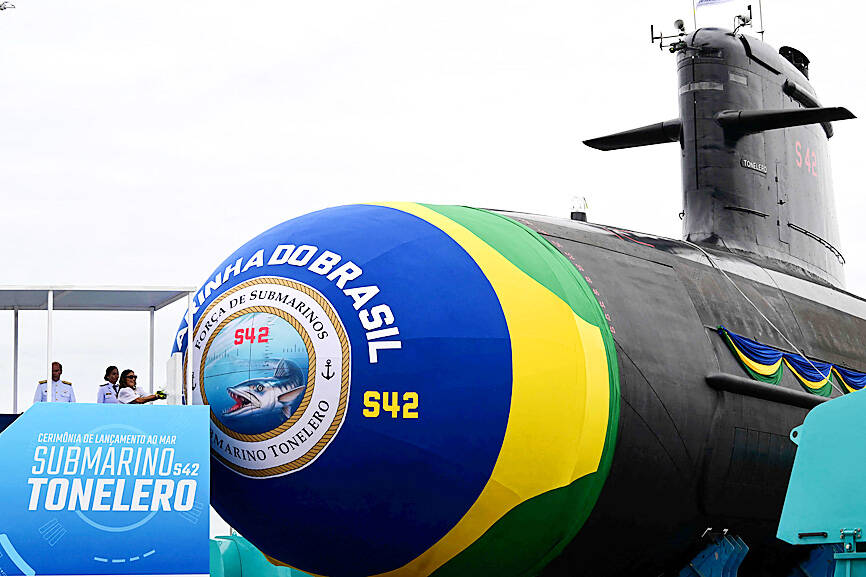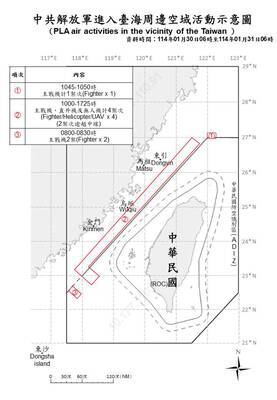French President Emmanuel Macron and Brazilian President Luiz Inacio Lula da Silva on Wednesday celebrated the launch of Brazil’s third French-designed submarine, which would help secure the country’s coastline.
The two men highlighted the importance of their countries’ defense partnership at a ceremony at a naval base in Itaguai, near Rio de Janeiro.
It is there that Brazil built the Tonelero, the third of four planned conventional diesel attack submarines, with training, equipment and technical assistance from France.

Photo: AFP
Under cloudy skies, the submarine was christened by Brazilian first lady Rosangela da Silva.
France’s and Brazil’s defense ties “will allow two important countries, each on a continent, to prepare so that we can face this adversity, without worrying about any type of war, because we are defenders of peace,” Lula said.
Despite differences, notably on the Ukraine war, Macron said “the great peaceful powers of Brazil and France” had “the same vision of the world.”
Macron is on a whirlwind tour of Brazil, a major economic ally, which began on Tuesday with the launch of a plan to raise more than US$1 billion in green investments to protect the Brazilian and Guyanese Amazon.
The visit is the first by a French president to Latin America’s economic giant in more than a decade.
A meeting between Macron and Lula in the Amazon, in which the two men were pictured beaming and clasping hands in the jungle, spawned a raft of Internet memes about their “bromance.”
The cozy scenes continued on Wednesday at the submarine launch.
With its 8,500km of coastline, Brazil is seeking to ensure the security of what it calls the “blue Amazon,” its immense exclusive economic zone through which more than 95 percent of its foreign trade passes and where it extracts 95 percent of its oil.
The construction of the submarines was outlined in a 2008 deal between Lula and former French president Nicolas Sarkozy, which also included the purchase of 50 Caracal helicopters.
The fourth submarine, the Angostura, is scheduled to be launched next year.

UNITED: The premier said Trump’s tariff comments provided a great opportunity for the private and public sectors to come together to maintain the nation’s chip advantage The government is considering ways to assist the nation’s semiconductor industry or hosting collaborative projects with the private sector after US President Donald Trump threatened to impose a 100 percent tariff on chips exported to the US, Premier Cho Jung-tai (卓榮泰) said yesterday. Trump on Monday told Republican members of the US Congress about plans to impose sweeping tariffs on semiconductors, steel, aluminum, copper and pharmaceuticals “in the very near future.” “It’s time for the United States to return to the system that made us richer and more powerful than ever before,” Trump said at the Republican Issues Conference in Miami, Florida. “They

GOLDEN OPPORTUNITY: Taiwan must capitalize on the shock waves DeepSeek has sent through US markets to show it is a tech partner of Washington, a researcher said China’s reported breakthrough in artificial intelligence (AI) would prompt the US to seek a stronger alliance with Taiwan and Japan to secure its technological superiority, a Taiwanese researcher said yesterday. The launch of low-cost AI model DeepSeek (深度求索) on Monday sent US tech stocks tumbling, with chipmaker Nvidia Corp losing 16 percent of its value and the NASDAQ falling 612.46 points, or 3.07 percent, to close at 19,341.84 points. On the same day, the Philadelphia Stock Exchange Semiconductor Sector index dropped 488.7 points, or 9.15 percent, to close at 4,853.24 points. The launch of the Chinese chatbot proves that a competitor can

TAIWAN DEFENSE: The initiative would involve integrating various systems in a fast-paced manner through the use of common software to obstruct a Chinese invasion The first tranche of the US Navy’s “Replicator” initiative aimed at obstructing a Chinese invasion of Taiwan would be ready by August, a US Naval Institute (USNI) News report on Tuesday said. The initiative is part of a larger defense strategy for Taiwan, and would involve launching thousands of uncrewed submarines, surface vessels and aerial vehicles around Taiwan to buy the nation and its partners time to assemble a response. The plan was first made public by the Washington Post in June last year, when it cited comments by US Indo-Pacific Commander Admiral Samuel Paparo on the sidelines of the Shangri-La Dialogue

MARITIME SECURITY: Of the 52 vessels, 15 were rated a ‘threat’ for various reasons, including the amount of time they spent loitering near subsea cables, the CGA said Taiwan has identified 52 “suspicious” Chinese-owned ships flying flags of convenience that require close monitoring if detected near the nation, the Coast Guard Administration (CGA) said yesterday, as the nation seeks to protect its subsea telecoms cables. The stricter regime comes after a Cameroon-flagged vessel was briefly detained by the CGA earlier this month on suspicion of damaging an international cable northeast of Taiwan. The vessel is owned by a Hong Kong-registered company with a Chinese address given for its only listed director, the CGA said previously. Taiwan fears China could sever its communication links as part of an attempt